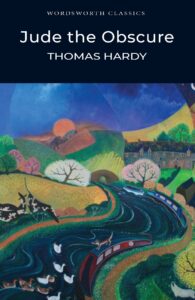In the penultimate section of On Photography (1973), ‘The Image-World’, Susan Sontag draws on how photography is treated in six works of fiction in her exploration of the nature of the medium. They are given here in chronological order.
Pierre; or, The Ambiguities by Herman Melville (1852) uses many conventions of Gothic fiction to develop the psychological, sexual, and family tensions between Pierre Glendinning and the four women in his life. He has a critical view of photography:
‘… with what infinite readiness now, the most faithful portrait if anyone could be taken by the Daguerreotype, whereas in former times a faithful portrait was only within the power of the monied, or mental aristocrats of the earth. How natural then the inference, that instead of, as in old times, immortalizing a genius, a portrait now only dayalized a dunce. Besides, when everybody has his portrait published, true distinction lies in not having yours published at all.’
In Thomas Hardy’s Jude the Obscure (1895) Jude falls in love with Sue Bridehead’s photograph before he meets her. In another episode, Jude discovers that Arabella has sold the maple frame with the photograph of himself in it, which he gave to her on their wedding day. This indicates to Jude ‘the utter death of every sentiment in his wife’ and is ‘the conclusive little stroke to demolish all sentiment in him.’
In Thomas Mann’s The Magic Mountain (1924) sanatorium-bound Hans Castorp is lovesick for the unattainable Clavida Chauchat. For him, ‘Clavdia’s X-ray portrait, showing not her face, but the delicate bony structure of the upper half of her body, and the organs of the thoracic cavity, surrounded by the pale, ghostlike envelope of flesh’, is a more precious trophy that the conventional portrait of her at which he once gazed longingly.
Narcissistic siblings, Elisabeth and Paul, Jean Cocteau’s protagonists in Les Enfants Terribles (1929), share their bedroom, their ‘secret room’, with photographs of boxers, murderers and movie stars. They cloister themselves in their lair surrounded by this personal pantheon to live out their private fantasy.
Prisoner Cincinnatus, in Vladimir Nabokov’s Invitation to a Beheading (1938) is shown a photohoroscope by M’sieur Pierre: photographs of Emmie, daughter of the Prison Director, from child, through to bride and to her death aged forty. It is made by retouching and using photographs on Emmie’s mother, what Nabokov calls a ‘parody of the work of time’. (And predating Photoshop by many decades.)
In Crash by J G Ballard (1973) Vaughan collects photographs of car accidents while preparing to stage his own death in a car crash. The fantasy is eroticised by the repeated perusal if these photographs.
Sontag uses these examples to illustrate variously:
- how the passionate collecting of photographs has a special appeal for those confined to indoor space;
- the magic embedded in photographs that makes us reluctant to destroy or throw them away;
- a photograph as a starting point for a romance;
- the erotic, sexual and obsessional nature of the photograph;
- the sometimes demeaning nature of the medium; and
- how photography can be a parody of itself.


